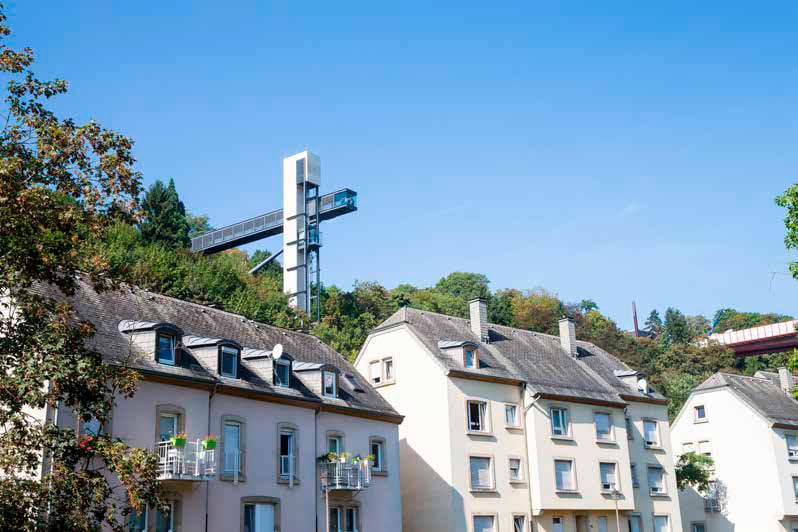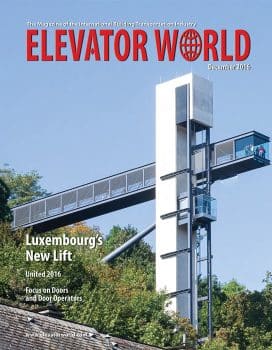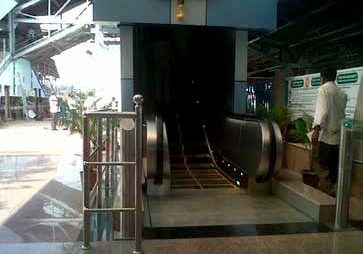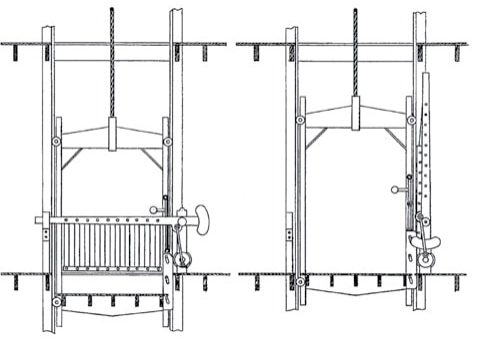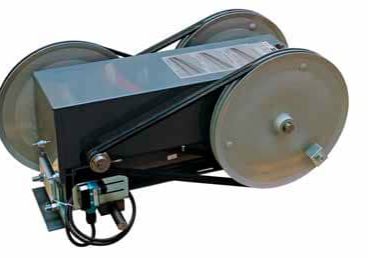Challenges did not stop Luxembourg from installing a lift and bridge to enhance access within one of its oldest districts.
photos by Laurent Blum, © Schindler
A land of castles and counts, Luxembourg has a history dating back to 963. Its quaint capital, Luxembourg City, is situated on two levels: the Alzette River Valley and the Upper City some 60 m above. It is composed of more than two dozen districts, of which Pfaffenthal is one of the oldest. This district gets its name from Pastor Fidelis Animarum Fidelium, or, Faithful Souls of the Faithful Shepherd, due to its being home to a large number of clergymen in the past. Nearby are United Nations Educational, Scientific and Cultural Organization (UNESCO) World Heritage sites. Roman coins and the remnants of a Roman bridge have been found in the area, and its varied topography and lush forests make it popular with hikers and bicyclists.
For 25 years, a lift approximately 1.5 km by foot and 3 km by vehicle from Pfaffenthal was the only way for pedestrians and cyclists to get back and forth between valley and hillside. That is, until July 22, when a new Schindler lift was unveiled amid much fanfare. Part of a broader policy to promote “green mobility” such as cycling, the semipanoramic lift links the Lower City to a 72-m-long steel-lattice footbridge, which itself offers impressive views and ultimately leads to Pescatore Park in the Upper City.
There is no charge to ride it. With a capacity of 5000 kg, the elevator is capable of carrying up to six cyclists and 12 people per trip. The cab has extra-wide doors on two sides to accommodate cyclists and wheelchair users, as well as ease the flow of traffic. Traveling at 2.5 mps, an hourly flow of about 150 cyclists and 300 pedestrians can be achieved. A one-way, 60-m trip takes 30 s.
Although it was a happy day when the lift finally opened, the road to it was paved with hardship, including bankruptcy of the original construction company, unstable soil that had to be reinforced and consequent cost overruns. The lift and bridge were originally scheduled to open in 2011, but the site lay dormant from August 2011 through October 2012 — until a new general contractor, CDCL, was able to take over.
Plans for a transportation system between valley and hill in Pfaffenthal date back nearly a decade. A feasibility study in 2007 considered four types of systems: escalators, funiculars, cable cars and elevators. A city brochure noted:
“It was quickly realized that escalators and funiculars would be unsuitable for the Pfaffenthal site due to overcoming the irregular profile of its slopes and the high costs of installation and maintenance. Similarly, the integration of such infrastructure into a UNESCO classified site involving a large number of relics or ancient fortifications would have raised a very large number of questions and difficult-to-predict constraints.”
An elevator was ultimately decided upon. A funicular is planned across the valley in the Kirchberg quarter, to be commissioned at the end of 2017 (if everything works out). As for the Pfaffenthal elevator, Guillaume Gauthe, Schindler New Installations & Large Projects manager, elaborated:
“Right from the beginning, due to the fact the project is located in an area close to a classified UNESCO area, the architect wanted a concept with the lowest visual impact. For this reason, and also due to technical constraints (sway due to wind, interface with the damping device), traveling cable was not an option. For the power part, it was decided to go with a wireless induction system in order to get a permanent power supply to the cabin combined with the lowest visual impact.
“For the transmission of information between the cabin and controller, we had to find a reliable Wi-Fi system that could offer the highest level of security. So, we actually have two Wi-Fi systems working in parallel: one fully secured to exchange all the safety information and another, more standard system to transfer non-sensitive data such as camera and cabin-screen information.”
EN 81-1 requires access every 11 m, which was not possible with the Pfaffenthal lift, built within a slender, concrete tower. The solution was to construct a rescue platform traveling on the guide rails above the cab. In addition to Schindler and CDCL, those involved in the project included architect Steinmetzdemeyer, mechanical engineer for elevator technology Jean Schmit Engineering and structural engineer Ingénieurs Conseils Associes.
The team had its work cut out for it. “It turned out the geology of the site was highly variable and full of surprises,” the brochure observed. Those surprises included large gaps in the rock and sandstone that required 72 permanent anchoring rods, the longest of which is 30 m, to stabilize a 16-m-tall retaining wall. Four of the rods are equipped with dynamometers, instruments that measure machine output.
The machine is powerful — the type normally found in high rises. The cabin weighs a few tons, and the Schindler FM630 asynchronous gearless motor that powers the system is approximately 75 kW, or more than 100 hp. Schindler also provided the TX GC controller and VF 288 PF1 energy-reinjection inverters. Other components were provided by:
- Bode Components GmbH: overspeed governor and cable brake
- Cobianchi Liftteile AG: safety gears
- MEILLER Aufzugtüren GmbH: stainless-steel doors
- Drako: 300-mT, 6-X-18-mm traction cables and 8-X-19-mm compensation cables
- Oleo International: counterweight and cabin buffers
- HEBO Industries: cabin
- Monteferro: guide rails that can withstand 105-kph winds
Significant safety features were implemented after extensive testing of materials’ reaction to wind, vibration and extreme temperatures. Hidden under the machinery within the top of the tower is an emergency escape car with its own engine and power supply. Emergency workers can access the main cabin using this car, which can also carry passengers back up to the bridge. The system can be run on a generator and is under permanent surveillance of a weather station and programmed to instantly shut down if certain wind, storm or ice conditions are present.
Hundreds of people came to the lift’s grand opening, a scene of dancing and celebration. A commemorative postage stamp was even issued for the occasion. Along with related improvements such as a concrete bike path and bike stations, pavilions, covered sitting areas, public restrooms and the soon-to-come funicular across the way, the Pfaffenthal lift promises to only enhance the allure of what is already a popular tourist destination! 🌐
Get more of Elevator World. Sign up for our free e-newsletter.
